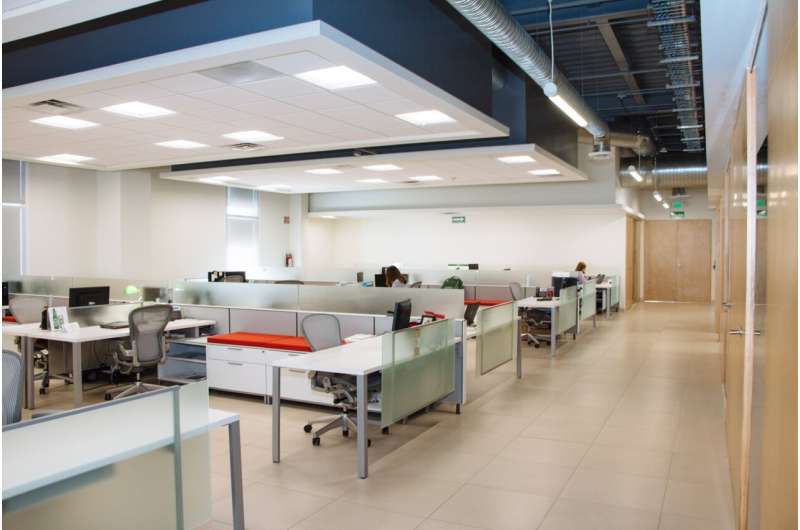This article has been reviewed according to Science X's editorial process and policies. Editors have highlighted the following attributes while ensuring the content's credibility:
fact-checked
peer-reviewed publication
trusted source
proofread
Same-level workplace falls set to rise amid surge in older female workforce numbers

Same-level falls in the workplace are set to rise amid rapid growth in the numbers of older female employees in the workforce, suggests Australian research published online first in the journal Occupational & Environmental Medicine.
Although workplace falls, overall, are more common among male employees, particularly falls from height, same-level falls are more common in older women, the findings indicate.
The prevalence and relative severity of workplace falls mean that better prevention strategies are needed to mitigate these sex-specific risk factors, conclude the researchers.
In 2016, an estimated 1.53 million deaths and 76.1 million years of lived disability were caused by workplace injuries, note the researchers. Falls accounted for more than a quarter of these figures.
The Australian workforce is aging: 50–64-year-olds made up 11% of employees in the mid-90s, rising to 21% in 2023. And aging in general is associated with a heightened risk of falls, say the researchers.
In a bid to uncover the risk profiles of workplace falls, they analyzed hospital admission records for the state of Victoria, Australia, between July 2017 and June 2022. Only patients older than 15 and admitted as a result of a work-related injury were included in the analysis.
The researchers compared fall and other injuries; 'falls from height' and 'same-level falls'; age and sex; presence of co-existing long-term conditions; time and place of injury; work and injury types; body parts involved; injury severity; and length of hospital stay.
Some 45,539 people were admitted to hospital for work-related injuries during the study period, of which 42,176 admissions were included in the final analysis
The average annual rate of hospital admission for a work-related injury was 2.54 in every 1,000 employees, but men outnumbered women: 3.91 vs. 0.98/1,000 employees.
Around one in five of these admissions (8,669; 21%) were associated with a fall, around half of which (52%) were falls from a height, while 37% were same-level/low falls.
Falls from ladder/scaffolds (21%), stairs/steps (9%), building/structure (8.5%) and different level falls (13.5%) made up those from height. Other specified and unspecified falls represented 1.5% and 10.5%, respectively. Over half of the fall injuries were fractures.
The average annual rate of hospital admission associated with a workplace fall was 0.52 in every 1000 employees: 0.68 for men and 0.34 for women.
Most work-related falls occurred in 25–64-year-olds, with men accounting for more than two thirds (69%) of all such falls. Women aged 45 and older, however, accounted for one in five (21%) of these falls and more than 5% of other workplace injuries.
While the rates for height falls were higher in men than in women: 0.44 vs. 0.08 per 1000 workers, especially among those aged 45 and older, same-level falls were higher in women: 0.21 vs. 0.18, particularly after the age of 50.
"It is possible that this higher rate of high falls among men is explained by the greater rates of men, particularly young men, relative to women, working in sectors in which working at height is relatively common, for example, construction, telecommunications, and mechanical engineering," suggest the researchers.
Same-level fall rates were relatively low in the youngest age groups, but rose sharply with increasing age, and were highest among the oldest female employees.
One in five (21%) of fallers had at least one co-existing health condition recorded during their hospital stay—30% of those with fall-related injuries and 19% of those with other work-related injuries.
Co-existing health problems were more common among those who had experienced a same-level fall than among those who had fallen from height, particularly circulatory, respiratory, and musculoskeletal conditions.
Falls, especially those from height, were more common among those working in construction, while other work-related injuries were more common among those working in agriculture, forestry, fishing and manufacturing.
Fall injuries were more likely to be serious, compared with other work-related injuries; this was particularly evident for falls from height. Prolonged length of stay was also more common for falls than for other types of injury. Nearly a third of hospital days due to work-related injuries were attributable to falls.
The findings relate to just one state in Australia so may not be more widely applicable, and the coding indicating where the fall occurred included a high proportion of 'unspecified' entries, acknowledge the researchers.
But they write, "Our findings add to a growing body of evidence suggesting that older working-aged women are at increased risk of same-level falls and fall-related injuries, particularly in the presence of comorbidity (whereas we observed a different risk profile for high falls, which were associated with males and which did not have a pronounced association with the number of comorbidities)."
They add, "For employers of middle-aged female workers, employers either need to consider a generalized approach to fall reduction among their entire workforce … or perhaps a targeted 'screening' approach in which workers are offered opportunities to share health information relevant to fall risk (including history of falls)."
They conclude, "Fall injuries, particularly same-level falls, are likely to increase in workplaces with current demographic changes, and employers, regulators, and policy makers could usefully consider raising the profile of workplace falls and developing effective prevention strategies."
More information: Epidemiology of work-related fall injuries resulting in hospitalisation: individual and work risk factors and severity, Occupational and Environmental Medicine (2024). DOI: 10.1136/oemed-2023-109079





















